 Facebook
Facebook
 X
X
 Instagram
Instagram
 TikTok
TikTok
 Youtube
Youtube
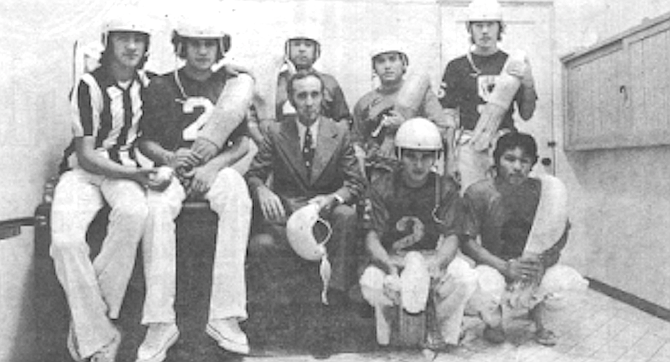
JAI ALAI is the fast-moving, fast-betting Basque ball court sport which, the game’s aficionados will quickly point out, is the world's most exciting game.
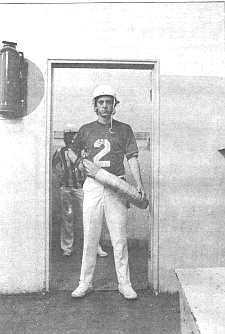
It is also one of the most dangerous. “I played baseball for five years as a kid,” says Steve Nodurft, “and the pelota hurts a lot more than any baseball.”
The pelota is a ball of hand-wound Brazilian rubber which is slightly smaller in size than a baseball and is harder than a golf ball. It takes three months to make and costs around $50. A good jai alai player can throw the pelota at speeds approaching 150 miles per hour.
“Even average players can throw the pelota at 130 miles per hour,” comments Nodurft.
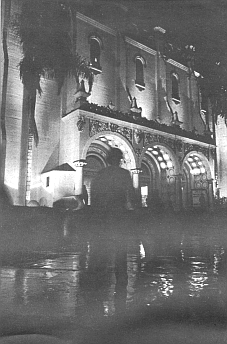
This 19-year-old Chula Vistan has seen plenty of pelotas. He is a thin, rangy kid with shaggy blond hair and lightning quick reflexes: Six days a week he leaves his house in the early evening and drives across the border to the Fronton Palacio in Tijuana, the sport’s West Coast home.
Nodurft is a professional jai alai player and something of a rarity in the game. He is an American ptaying a fiercely competitive game which is dominated by Basque players. In the three decades of operation, the Fronton Palacio has had only three Americans play on the court professionally.
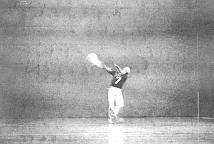
Nodurft's case is extraordinary because he started throwing the pelota only 18 months ago. “I was a ball boy at the MGM hotel in Las Vegas,” he explains. “My dad is manager of operations there, so I had an in. One day, the player’s manager asked me if I wanted to try playing the game. I jumped at the chance.”
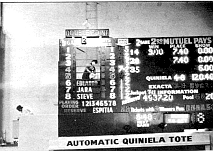
For six months he practiced cradling the pelota in the long wicker basket, called a cesta, which is strapped to the player’s right arm. He learned to throw the pelota with a straight-arm motion, using the wrist to snap the cesta and give the ball its blinding speed. Within a year he had perfected his skills to the point where he could play professionally. A few quick calls were made to Tijuana and after a vigorous tryout, Nodurft found himself under contract at the Fronton Palacio.
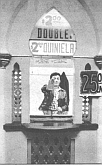
In his brief career, Nodurft has been hit several times by the rock-hard pelota and has had a few near-misses. Every professional sport has its own dangers, and in jai alai sooner of later you’re going to get hit.
“The first time happened last June,” recalls Nodurft. “I was playing back-court in doubles and I watched the pelota come off the front wall back towards me. It was high and I had to make the decision whether to try for it or let it go and give the front man a chance at it. I jumped, felt the pelota nick the cesta, then rebound off the wall and hit my leg.
“Luckily, it hit on the soft part of my thigh. I walked off the court feeling a little nervous, a little afraid. It didn’t start swelling until later and I felt good enough to go out and finish the night. But let me tell you, if the same kind of shot had come at me again that night I would have let it go.”
The Tijuana Fronton is considered a slow court by most players. The front wall is made of stone, not 12-inch granite blocks as are most stateside frontons. Granite gives the pelota a harder surface to rebound off and makes the game faster and more dangerous.
To cut down on serious injuries, plastic safety helmets very much like those used by baseball batters have become mandatory equipment. The frontons are sealed off by heavy wire chain-link fences and thick plexiglass. Still accidents occur. As Sports Illustrated noted, “The combination of speed, size and hardness is savage... This year, in the Orlando (Florida) fronton, one player lost an eye. Last year a pelota, which had already traveled 176 feet, hit the players' cage wiring with such velocity that it expanded the diamond mesh.” In that accident the players’ manager got 27 stitches in his forehead.
Though most shots are thrown hard and straight, the better players can put spin on the pelota, making it dance and flutter as it comes off the wall. There are a variety of shots a player must master before he is allowed to play professional jai alai. The most dramatic is the rebote, the shot where the ball is fielded off the back wall and then thrown in one spinning motion towards the front. The full weight of the body is put behind the throw, making the rebote perhaps the hardest thrown and most dangerous shot in the game.
“I was playing singles,” recalls Nodurft, “and the man I competed against had no rebote. He caught the ball and I moved to the side to get out of His way. But he hooked the shot and the ball just missed my leg.”
When the ball is moving over 100 miles an hour, there isn’t much you can do. “By the time you react, the pelota is 20 yards past you. If the ball is going to hit you, it’s going to hit you. There isn’t much you can do about it.”
SITTING IN the comfortable Fronton Palacio, it is easy to see how a spectator gets caught up in the game. Even on a slow Monday night, the jai alai fans are a vocal group, screaming out the names of their favorite players or booing them if their performance is not up to expectations. Betting is one reason for the crowd’s excitement. But even the novice who knows nothing about the scoring or the betting can get hooked as players leap high up the wall, cupping the pelota in the wicker cesta, and then making the shot, all in one swirling motion.
“Jai alai is a sport that lends itself to betting,”* says Larry Jones, a jai alai aficionado and head of his own Mexican tour business. “But unlike the horses and the dogs, it offers something beyond betting. There are thousands who just come to watch the players. It’s an exciting sport.”
Jai alai players are streak performers, having good weeks when they can do nothing wrong on the court and other weeks when luck seems to elude them at every turn. “You just have to wait it out,” says Nodurft. “It’s a long season and every player gets down and starts thinking he’s washed up or is tired of the game. You have to think positive, not dwell on your mistakes, and eventually you work yourself out of the slump.” Jai alai, as played in Tijuana, is an exhausting game. Players are on the court 12 months of the year, with only a few days off for vacations. Fatigue is always a factor, and the players who have been around for several years learn to pace themselves. Those who go all-out every night, week after week, end up burning themselves out.
The week begins on Friday, when the crowds are big for the weekend, and it ends Wednesday. It is a strenuous sport, one that is hard on the body. The most common injuries are shin splints, ankle injuries, and torn cartilage in the knee. Some players develop sore elbows much like tennis players, because of the constant straining of muscles on the right side of the body. The plusher frontons have a masseuse to keep a player’s muscles loose and supple. In the Fronton Palacio, there is none, and pulled muscles are a common complaint.
“You can tell in the first few days how your week will be,” explained Nodurft. “Your legs get shaky after a day off. But if you con’t firm up by Sunday, then you’re going to have an off week. That’s especially true at the Fronton Palacio. The court is not fast like in Las Vegas. On a dead court you must put everything into the throw. That puts a great strain on your body.”
In compensation, jai alai players are paid well, though not as handsomely as many professional athletes. The best players in Tijuana can expect to make upwards of $15,000 a year. The average salary is around $8,000.
Tijuana is at the bottom of the pay scale, and the Florida frontons, which are newer and have larger wagering handles, pay their players two to three times as much. Top players at the Bridgeport fronton can earn $200,000 a year.
The reason, of course, is economics. The Palacio Fronton takes in weekly handles of $200,000, which is up from a few years ago. But it hardly compares with the daily handles in Miami which hit twice that amount in a single day.
It also does not match the wild success the game has enjoyed along the Eastern seaboard. Jai alai was introduced to the Connecticut cities of Bridgeport and Hartford earlier this year and the results were surprising. Neither city is a tourist mecca; Bridgeport is a grimy industrial town and Hartford is the deadly dull center of the insurance world. Yet lines at the betting windows are long in both places. Hartford hoped for wagering handles of $30 million during the seven-month season, yet made that much in less than four months. As Time magazine noted, “Nearly $1 million a day pours through the betting windows at Hartford and Bridgeport from capacity crowds newly hooked on the world’s fastest game and the fast buck.”
Yet this sudden interest in the sport has not filtered down to San Diego. One reason, perhaps, is Tijuana. “I think jai alai would be a big success in the San Diego area,” says Larry Jones. “Just being on this side of the border would be an advantage. I hate to say this, but there are thousands of local residents who won’t step foot over the border. If jai alai was open here a lot of these people would go see it and bet on it. But they don’t now, because the only game in town happens to be in Tijuana.”
Jai alai has suffered in the past from government interference, disastrous labor strikes, a devastating fire, and more recently low attendance due to the peso devaluation.
ONE REASON that jai alai is still being played is due to the persistence of Mariano Escobedo, the current owner of the Fronton Palacio and the son of Mariano Escobedo, Sr., the man who first brought the game to Tijuana in the Thirties.
“To Escobedo, jai alai is both a business and a hobby,” observes an American friend. “He says he had the good luck to be born independently wealthy and that’s true. But his father built the Fronton Palacio and Escobedo is determined to keep it going. It’s a matter of pride. He could make a lot more by tearing the fronton down and using the real estate for other business ventures.”
Indeed, if the Palacio lacks the glitter and tinsel of the MGM—if it does not have the speed of the newer courts in Florida or the betting handles of Bridgport and Hartford—it still is a clean, comfortable fronton. The action down on the court crackles as the pelota slams off the front wall and players jockey to make the return shot.
And the game is cheap entertainment.
General admission is $1.25 and good reserved seating is just $2.00. Betting jai alai follows the lead of horse-racing. The minimum bet is $2. You can pick a player to win, place, or show. Or you can play the combination like the quiniela, exacta, or the seven-eleven. The systems are easy to learn and are carefully explained in the daily program, which lists the 12 games played each night and handicaps the players.
One advantage to jai alai betting is that the game itself is on the up and up. In more than 40 years, there has never been a betting scandal in the United States or in Tijuana. How is that possible?
“It’s the way players are handicapped,” says Jim Redfern, the Palacio’s public relations man. “The game is impossible to fix. There are just too many variables in the game that can go wrong.
To further insure the purity of the game, players are prohibited from betting on themselves. It’s a strict rule and one which the players abide by.
“Jai alai players are party goers and womanizers,” says Redfern, “But when it comes down to betting jai alai, they are as pure as their patron saint. If a player gets caught betting on a game, he gets blackballed. And not just here, but anywhere the game is played. The price is just too high to pay."
Jai alai is played in such diverse places as Macao, Manila, Mexico, the United States, and of course Spain. Yet despite its international acceptance, the players are part of a unique club, just as major league baseball players are. Once blackballed, their careers are finished.
Understandably, jai alai people are touchy about scandals or hints of possible foul play. Nodurft was prohibited from playing at the MGM because his father was the general manager of the fronton. It might make gamblers look askance if they saw him playing on the court.
Which was one reason he came to Tijuana. That, and because the Fronton Palacio is a good place for younger players to start out. His contract runs out in December and already he is eyeing a chance to play in Reno, if and when plans for a second MGM fronton go through.
“I don’t plan to play all my life,” he says. “Some day I want to get into management like my dad is. I love the game and want to play ten years. The first couple of times I threw the ball, it went straight down to the floor. But I knew it was the game I wanted to play. I played a lot of other sports in high school, like football and baseball, but they weren’t anything like jai alai. The speed is just incredible!”
The game might yet become a fad of sorts in the States. Nodurft says that when he started practicing in Las Vegas there were only two other kids trying the learn the intricate hand-wrist-body movements needed to throw the pelota.
“Now I hear there are 35 kids practicing,” he says.


JAI ALAI is the fast-moving, fast-betting Basque ball court sport which, the game’s aficionados will quickly point out, is the world's most exciting game.

It is also one of the most dangerous. “I played baseball for five years as a kid,” says Steve Nodurft, “and the pelota hurts a lot more than any baseball.”
The pelota is a ball of hand-wound Brazilian rubber which is slightly smaller in size than a baseball and is harder than a golf ball. It takes three months to make and costs around $50. A good jai alai player can throw the pelota at speeds approaching 150 miles per hour.
“Even average players can throw the pelota at 130 miles per hour,” comments Nodurft.

This 19-year-old Chula Vistan has seen plenty of pelotas. He is a thin, rangy kid with shaggy blond hair and lightning quick reflexes: Six days a week he leaves his house in the early evening and drives across the border to the Fronton Palacio in Tijuana, the sport’s West Coast home.
Nodurft is a professional jai alai player and something of a rarity in the game. He is an American ptaying a fiercely competitive game which is dominated by Basque players. In the three decades of operation, the Fronton Palacio has had only three Americans play on the court professionally.

Nodurft's case is extraordinary because he started throwing the pelota only 18 months ago. “I was a ball boy at the MGM hotel in Las Vegas,” he explains. “My dad is manager of operations there, so I had an in. One day, the player’s manager asked me if I wanted to try playing the game. I jumped at the chance.”

For six months he practiced cradling the pelota in the long wicker basket, called a cesta, which is strapped to the player’s right arm. He learned to throw the pelota with a straight-arm motion, using the wrist to snap the cesta and give the ball its blinding speed. Within a year he had perfected his skills to the point where he could play professionally. A few quick calls were made to Tijuana and after a vigorous tryout, Nodurft found himself under contract at the Fronton Palacio.

In his brief career, Nodurft has been hit several times by the rock-hard pelota and has had a few near-misses. Every professional sport has its own dangers, and in jai alai sooner of later you’re going to get hit.
“The first time happened last June,” recalls Nodurft. “I was playing back-court in doubles and I watched the pelota come off the front wall back towards me. It was high and I had to make the decision whether to try for it or let it go and give the front man a chance at it. I jumped, felt the pelota nick the cesta, then rebound off the wall and hit my leg.
“Luckily, it hit on the soft part of my thigh. I walked off the court feeling a little nervous, a little afraid. It didn’t start swelling until later and I felt good enough to go out and finish the night. But let me tell you, if the same kind of shot had come at me again that night I would have let it go.”
The Tijuana Fronton is considered a slow court by most players. The front wall is made of stone, not 12-inch granite blocks as are most stateside frontons. Granite gives the pelota a harder surface to rebound off and makes the game faster and more dangerous.
To cut down on serious injuries, plastic safety helmets very much like those used by baseball batters have become mandatory equipment. The frontons are sealed off by heavy wire chain-link fences and thick plexiglass. Still accidents occur. As Sports Illustrated noted, “The combination of speed, size and hardness is savage... This year, in the Orlando (Florida) fronton, one player lost an eye. Last year a pelota, which had already traveled 176 feet, hit the players' cage wiring with such velocity that it expanded the diamond mesh.” In that accident the players’ manager got 27 stitches in his forehead.
Though most shots are thrown hard and straight, the better players can put spin on the pelota, making it dance and flutter as it comes off the wall. There are a variety of shots a player must master before he is allowed to play professional jai alai. The most dramatic is the rebote, the shot where the ball is fielded off the back wall and then thrown in one spinning motion towards the front. The full weight of the body is put behind the throw, making the rebote perhaps the hardest thrown and most dangerous shot in the game.
“I was playing singles,” recalls Nodurft, “and the man I competed against had no rebote. He caught the ball and I moved to the side to get out of His way. But he hooked the shot and the ball just missed my leg.”
When the ball is moving over 100 miles an hour, there isn’t much you can do. “By the time you react, the pelota is 20 yards past you. If the ball is going to hit you, it’s going to hit you. There isn’t much you can do about it.”
SITTING IN the comfortable Fronton Palacio, it is easy to see how a spectator gets caught up in the game. Even on a slow Monday night, the jai alai fans are a vocal group, screaming out the names of their favorite players or booing them if their performance is not up to expectations. Betting is one reason for the crowd’s excitement. But even the novice who knows nothing about the scoring or the betting can get hooked as players leap high up the wall, cupping the pelota in the wicker cesta, and then making the shot, all in one swirling motion.
“Jai alai is a sport that lends itself to betting,”* says Larry Jones, a jai alai aficionado and head of his own Mexican tour business. “But unlike the horses and the dogs, it offers something beyond betting. There are thousands who just come to watch the players. It’s an exciting sport.”
Jai alai players are streak performers, having good weeks when they can do nothing wrong on the court and other weeks when luck seems to elude them at every turn. “You just have to wait it out,” says Nodurft. “It’s a long season and every player gets down and starts thinking he’s washed up or is tired of the game. You have to think positive, not dwell on your mistakes, and eventually you work yourself out of the slump.” Jai alai, as played in Tijuana, is an exhausting game. Players are on the court 12 months of the year, with only a few days off for vacations. Fatigue is always a factor, and the players who have been around for several years learn to pace themselves. Those who go all-out every night, week after week, end up burning themselves out.
The week begins on Friday, when the crowds are big for the weekend, and it ends Wednesday. It is a strenuous sport, one that is hard on the body. The most common injuries are shin splints, ankle injuries, and torn cartilage in the knee. Some players develop sore elbows much like tennis players, because of the constant straining of muscles on the right side of the body. The plusher frontons have a masseuse to keep a player’s muscles loose and supple. In the Fronton Palacio, there is none, and pulled muscles are a common complaint.
“You can tell in the first few days how your week will be,” explained Nodurft. “Your legs get shaky after a day off. But if you con’t firm up by Sunday, then you’re going to have an off week. That’s especially true at the Fronton Palacio. The court is not fast like in Las Vegas. On a dead court you must put everything into the throw. That puts a great strain on your body.”
In compensation, jai alai players are paid well, though not as handsomely as many professional athletes. The best players in Tijuana can expect to make upwards of $15,000 a year. The average salary is around $8,000.
Tijuana is at the bottom of the pay scale, and the Florida frontons, which are newer and have larger wagering handles, pay their players two to three times as much. Top players at the Bridgeport fronton can earn $200,000 a year.
The reason, of course, is economics. The Palacio Fronton takes in weekly handles of $200,000, which is up from a few years ago. But it hardly compares with the daily handles in Miami which hit twice that amount in a single day.
It also does not match the wild success the game has enjoyed along the Eastern seaboard. Jai alai was introduced to the Connecticut cities of Bridgeport and Hartford earlier this year and the results were surprising. Neither city is a tourist mecca; Bridgeport is a grimy industrial town and Hartford is the deadly dull center of the insurance world. Yet lines at the betting windows are long in both places. Hartford hoped for wagering handles of $30 million during the seven-month season, yet made that much in less than four months. As Time magazine noted, “Nearly $1 million a day pours through the betting windows at Hartford and Bridgeport from capacity crowds newly hooked on the world’s fastest game and the fast buck.”
Yet this sudden interest in the sport has not filtered down to San Diego. One reason, perhaps, is Tijuana. “I think jai alai would be a big success in the San Diego area,” says Larry Jones. “Just being on this side of the border would be an advantage. I hate to say this, but there are thousands of local residents who won’t step foot over the border. If jai alai was open here a lot of these people would go see it and bet on it. But they don’t now, because the only game in town happens to be in Tijuana.”
Jai alai has suffered in the past from government interference, disastrous labor strikes, a devastating fire, and more recently low attendance due to the peso devaluation.
ONE REASON that jai alai is still being played is due to the persistence of Mariano Escobedo, the current owner of the Fronton Palacio and the son of Mariano Escobedo, Sr., the man who first brought the game to Tijuana in the Thirties.
“To Escobedo, jai alai is both a business and a hobby,” observes an American friend. “He says he had the good luck to be born independently wealthy and that’s true. But his father built the Fronton Palacio and Escobedo is determined to keep it going. It’s a matter of pride. He could make a lot more by tearing the fronton down and using the real estate for other business ventures.”
Indeed, if the Palacio lacks the glitter and tinsel of the MGM—if it does not have the speed of the newer courts in Florida or the betting handles of Bridgport and Hartford—it still is a clean, comfortable fronton. The action down on the court crackles as the pelota slams off the front wall and players jockey to make the return shot.
And the game is cheap entertainment.
General admission is $1.25 and good reserved seating is just $2.00. Betting jai alai follows the lead of horse-racing. The minimum bet is $2. You can pick a player to win, place, or show. Or you can play the combination like the quiniela, exacta, or the seven-eleven. The systems are easy to learn and are carefully explained in the daily program, which lists the 12 games played each night and handicaps the players.
One advantage to jai alai betting is that the game itself is on the up and up. In more than 40 years, there has never been a betting scandal in the United States or in Tijuana. How is that possible?
“It’s the way players are handicapped,” says Jim Redfern, the Palacio’s public relations man. “The game is impossible to fix. There are just too many variables in the game that can go wrong.
To further insure the purity of the game, players are prohibited from betting on themselves. It’s a strict rule and one which the players abide by.
“Jai alai players are party goers and womanizers,” says Redfern, “But when it comes down to betting jai alai, they are as pure as their patron saint. If a player gets caught betting on a game, he gets blackballed. And not just here, but anywhere the game is played. The price is just too high to pay."
Jai alai is played in such diverse places as Macao, Manila, Mexico, the United States, and of course Spain. Yet despite its international acceptance, the players are part of a unique club, just as major league baseball players are. Once blackballed, their careers are finished.
Understandably, jai alai people are touchy about scandals or hints of possible foul play. Nodurft was prohibited from playing at the MGM because his father was the general manager of the fronton. It might make gamblers look askance if they saw him playing on the court.
Which was one reason he came to Tijuana. That, and because the Fronton Palacio is a good place for younger players to start out. His contract runs out in December and already he is eyeing a chance to play in Reno, if and when plans for a second MGM fronton go through.
“I don’t plan to play all my life,” he says. “Some day I want to get into management like my dad is. I love the game and want to play ten years. The first couple of times I threw the ball, it went straight down to the floor. But I knew it was the game I wanted to play. I played a lot of other sports in high school, like football and baseball, but they weren’t anything like jai alai. The speed is just incredible!”
The game might yet become a fad of sorts in the States. Nodurft says that when he started practicing in Las Vegas there were only two other kids trying the learn the intricate hand-wrist-body movements needed to throw the pelota.
“Now I hear there are 35 kids practicing,” he says.
Comments